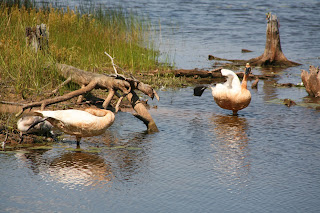WINGIN’
IT
By
Kate Crowley
photos Mike Link
Typically the earliest
arrivals in spring migration are waterfowl; Canada geese, followed by the
myriad duck species. We recently drove
over the Moosehorn River north of Willow River and saw both geese and mallard
ducks swimming about. The rivers are
opening up earlier this year which allows waterfowl to position themselves for
prime territory before the lakes are ice free.
In recent years more and more people are seeing Trumpeter swans arriving
with the other waterfowl.
A couple weeks ago I
heard one woman tell another about the swans that were out on the ice on
Sturgeon Lake. Her husband was concerned
about their condition and was about to go out and check on them when they took
off. On the same day that we saw the
geese and ducks on the river we spotted six Trumpeters in a stubble corn
field. It was an odd sight - not where
we expect to see these large birds, but they were probably scavenging for leftover
grain.
The story of our
Trumpeter swan population is one of a successful recovery effort that began in
the 1960s when the Hennepin County Parks collected some birds in Montana in an
effort to establish some breeding pairs here. That didn’t happen until 1969
when a few birds nested outside of the County. These were first successful Trumpeter
swan nests in Minnesota since the 1880s. Since those early efforts, there have been more collection of eggs from
other states and we have now reached a point where more than 350 swans have been released and our
Trumpeter swan population exceeds 2,400 birds.
These are the sorts of
stories we long to hear; wildlife that was extirpated from our state because of
bad human behavior (overhunting in particular) are restored because of our
better natures – these were government funded projects and our tax dollars
allowed them to succeed. There are only
a few birds that impress us as much with their size, beauty and gracefulness
and swans are near the top of the list.
They have even been become a part of childhood literature and the
promise of transformation in the story of The Ugly Duckling.
Minnesota’s story of
restoration is not without worry however.
These magnificent birds still face regular threats in the form of lead
poisoning, power line collisions, habitat loss and illegal or poor hunting
habits.
One of the most
insidious threats is that of lead poisoning. Far too many fishing and hunting
enthusiasts are still using lead sinkers and bullets. I know most of these people consider
themselves to be conservationists, but if that is truly the case then the use of
lead in either activity should stop. Swans ingest lead sinkers by probing the
bottoms of lakes and ponds for tubers and tubers. Nearly 40% of all Minnesota trumpeter swan
deaths come from lead poisoning.
Habitat loss is a
constant problem as lakeshore property is highly sought and these birds
absolutely need undisturbed shallow vegetation found along the edges of lakes
and ponds in which to build their nests.
They will also use the tops of old beaver and muskrat lodges. Highly sensitive and protective of their
territories, they are easily disturbed by motorized boat activity near their
nests.
Every year we hear
about someone who has shot a Swan and claims they thought it was a Snow
goose. All I can say if a person can’t
distinguish between a bird (Trumpeter swan) approximately five feet in length, with a
wingspan of six to eight feet and another (Snow goose) which is half as long,
has a wingspan of four feet and has black wingtips – then they should not be
called a hunter; and should be prosecuted for their ‘mistake’.
Being aware of the
dangers these birds face makes their presence in our region all the more
special. I hope that you will be able to
see some this spring and summer and celebrate all the efforts that have gone
into their successful return to our State and lives.






Comments
Post a Comment